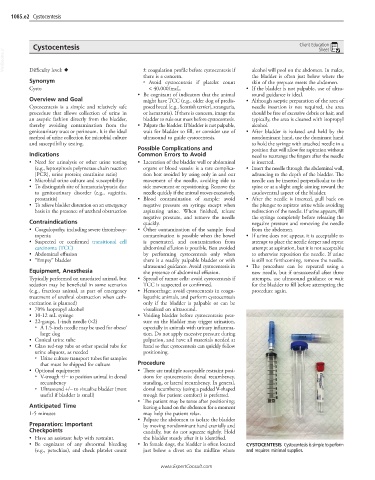Page 2173 - Cote clinical veterinary advisor dogs and cats 4th
P. 2173
1085.e2 Cystocentesis
Cystocentesis Client Education
Sheet
VetBooks.ir
± coagulation profile before cystocentesis if
Difficulty level: ♦
there is a concern. alcohol will pool on the abdomen. In males,
the bladder is often just below where the
Synonym ○ Avoid cystocentesis if platelet count skin of the prepuce meets the abdomen.
Cysto < 40,000/mcL. • If the bladder is not palpable, use of ultra-
• Be cognizant of indicators that the animal sound guidance is ideal.
Overview and Goal might have TCC (e.g., older dog of predis- • Although aseptic preparation of the area of
Cystocentesis is a simple and relatively safe posed breed [e.g., Scottish terrier], stranguria, needle insertion is not required, the area
procedure that allows collection of urine in or hematuria). If there is concern, image the should be free of excessive debris or hair, and
an aseptic fashion directly from the bladder, bladder to rule out mass before cystocentesis. typically, the area is cleaned with isopropyl
thereby avoiding contamination from the • Palpate the bladder. If bladder is not palpable, alcohol.
genitourinary tract or perineum. It is the ideal wait for bladder to fill, or consider use of • After bladder is isolated and held by the
method of urine collection for microbial culture ultrasound to guide cystocentesis. nondominant hand, use the dominant hand
and susceptibility testing. to hold the syringe with attached needle in a
Possible Complications and position that will allow for aspiration without
Indications Common Errors to Avoid need to rearrange the fingers after the needle
• Need for urinalysis or other urine testing • Laceration of the bladder wall or abdominal is inserted.
(e.g., leptospirosis polymerase chain reaction organs or blood vessels: is a rare complica- • Insert the needle through the abdominal wall,
[PCR], urine protein; creatinine ratio) tion best avoided by using only in and out advancing to the depth of the bladder. The
• Microbial urine culture and susceptibility movement of the needle, avoiding side to needle can be inserted perpendicular to the
• To distinguish site of hematuria/pyuria due side movement or repositioning. Remove the spine or at a slight angle aiming toward the
to genitourinary disorder (e.g., vaginitis, needle quickly if the animal moves excessively. caudoventral aspect of the bladder.
prostatitis) • Blood contamination of sample: avoid • After the needle is inserted, pull back on
• To relieve bladder distention on an emergency negative pressure on syringe except when the plunger to aspirate urine while avoiding
basis in the presence of urethral obstruction aspirating urine. When finished, release redirection of the needle. If urine appears, fill
negative pressure, and remove the needle the syringe completely before releasing the
Contraindications quickly. negative pressure and removing the needle
• Coagulopathy, including severe thrombocy- • Other contamination of the sample: fecal from the abdomen.
topenia contamination is possible when the bowel • If urine does not appear, it is acceptable to
• Suspected or confirmed transitional cell is penetrated, and contamination from attempt to place the needle deeper and repeat
carcinoma (TCC) abdominal effusion is possible. Best avoided attempt at aspiration, but it is not acceptable
• Abdominal effusion by performing cystocentesis only when to otherwise reposition the needle. If urine
• “Empty” bladder there is a readily palpable bladder or with is still not forthcoming, remove the needle.
ultrasound guidance. Avoid cystocentesis in • The procedure can be repeated using a
Equipment, Anesthesia the presence of abdominal effusion. new needle, but if unsuccessful after three
Typically performed on unsedated animal, but • Spread of tumor cells: avoid cystocentesis if attempts, use ultrasound guidance or wait
sedation may be beneficial in some scenarios TCC is suspected or confirmed. for the bladder to fill before attempting the
(e.g., fractious animal, as part of emergency • Hemorrhage: avoid cystocentesis in coagu- procedure again.
treatment of urethral obstruction when cath- lopathic animals, and perform cystocentesis
eterization is planned) only if the bladder is palpable or can be
• 70% Isopropyl alcohol visualized on ultrasound.
• 10-12 mL syringe • Voiding bladder before cystocentesis: pres-
• 22-gauge, 1-inch needle (×2) sure on the bladder may trigger urination,
○ A 1.5-inch needle may be used for obese/ especially in animals with urinary inflamma-
large dog tion. Do not apply excessive pressure during
• Conical urine tube palpation, and have all materials needed at
• Glass red-top tube or other special tube for hand so that cystocentesis can quickly follow
urine aliquots, as needed positioning.
○ Urine culture transport tubes for samples
that must be shipped for culture Procedure
• Optional equipment: • There are multiple acceptable restraint posi-
○ V-trough +/− to position animal in dorsal tions for cystocentesis: dorsal recumbency,
recumbency standing, or lateral recumbency. In general,
○ Ultrasound +/− to visualize bladder (most dorsal recumbency (using a padded V-shaped
useful if bladder is small) trough for patient comfort) is preferred.
• The patient may be tense after positioning;
Anticipated Time leaving a hand on the abdomen for a moment
1-5 minutes may help the patient relax.
• Palpate the abdomen to isolate the bladder
Preparation: Important by moving nondominant hand cranially and
Checkpoints caudally, but do not squeeze tightly. Hold
• Have an assistant help with restraint. the bladder steady after it is identified.
• Be cognizant of any abnormal bleeding • In female dogs, the bladder is often located CYSTOCENTESIS Cystocentesis is simple to perform
(e.g., petechiae), and check platelet count just below a divot on the midline where and requires minimal supplies.
www.ExpertConsult.com

